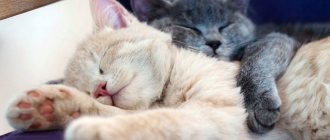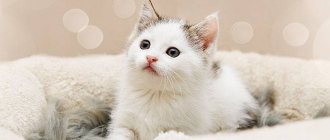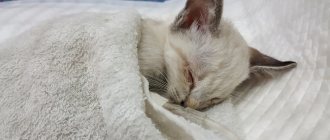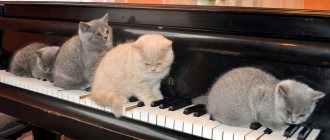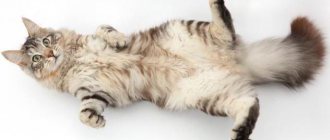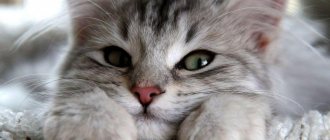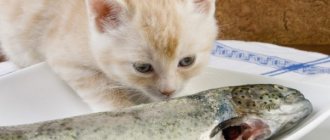Cats have a number of different ways to express their mood and react to what is happening, which can be expressed through facial expressions, behavior and body movements. Scientists have found that sign language includes about fifty movements of the head, tail and ears. Everyone knows how an animal behaves when expressing its unfriendly attitude: its back arches, its fur stands on end. Thus, it tries to look more impressive in the eyes of the enemy.
How to understand that cats are friends?
Cats that play do not show their claws, and if claws are visible, they are not used to intentionally injure an opponent. On the contrary, if you see cats purposefully using their claws as weapons, it is most likely a fight. Watch how cats bite each other.
Interesting materials:
Who owns Tasteville? Who was awarded the title of Hero of the Soviet Union 3 times? Who did Galitsky sell the magnet to? Who did Chisora lose to? Who is pumpkin contraindicated for? Who is contraindicated in boiled beets? Who used to own Istanbul? Who do you have to give way to when turning left Ticket No. 34 Question 14? Who to call if the roads are not cleared? Who is Agata Muceniece by zodiac sign?
How cats talk to us
Cats and cats communicate with each other using body movements and smells, rarely using sounds. When we are around people, they notice that we respond better to their voice than to body language.
Cats communicate with each other using body language and smells.
Therefore, animals change their communication style to exploit human strengths and weaknesses.
Our pets view us as surrogate mothers and use their voices to tell us what they want. A little kitten, meowing, tells its mother that it feels bad. As adults, cats actively use this to communicate with people.
Types and meaning of cat talk
To express its emotions with its voice, a pet always pronounces exactly those sounds that are suitable for a given situation. They differ in strength and timbre (high or low). Any trouble is expressed by low sounds, and peace and pleasure are expressed by high sounds.
Meowing in the form of a long “meow” is a greeting to the owner who has returned home or a request, and sometimes a complaint. The short “me” means confusion or question. The goal of any “meow” is to attract the attention of others. If the owner does not respond to the first polite “meow”, the cat will ask more demandingly and loudly in order to achieve results.
Vowel sounds in different keys are a cat’s request:
- “I want to go outside”;
- “it’s time to eat”;
- "I'm upset";
- "I'm in pain."
A very loud cry from a cat is a sign of panic, a warning to owners about mortal danger in the event of a fire, earthquake or other disaster. Sometimes a pet mourns the death of a friend or moving to a new home with this cry.
Many owners have paid attention to “silent meowing,” when a cat, looking at a person, opens its mouth, but there is no sound. In fact, it exists, but in the ultrasonic range, which only animals can hear. But a person more often reacts to such a quiet “meow”, and the cat notices this and uses it with might and main.
Purring (special cooing sounds) shows the calm state of the cat, without aggression. He is happy with everything. Mother cats purr for kittens: everything is fine, there is no danger. This is how a pet shows its affection for its owner. He is happy when petted, purrs and squints his eyes. If he follows you around, tries to climb onto your lap, brings you a toy or food - this is also a sign of his love. When he rubs his head against your legs or “butts” his forehead, massages with his paws, licks your hand and sits next to you if you are sick - do not doubt that you are more important to him than anything in the world.
By purring, the cat shows that he is happy and loves you.
If dissatisfied, the cat purrs in low tones, warning that you are interfering in its affairs. Hisses when scared, but does not dare to attack. If he snorts and moves forward when meeting an enemy, he is ready for a fight. With a loud howl, he tries to break the enemy’s fighting spirit so that he retreats first.
Scientists have found that cats can produce hundreds of different sounds, and at least 15 of them are meows. Among them there are consonants: “g”, “v”, “f”, “r”, “m”, “n”. There is even a “Dictionary of Cat Language”, which includes more than 3 thousand “words” and “concepts” for different breeds of cats.
Cat body language and body language
In addition to sounds, cats communicate with each other and with people using gestures and different positions of their bodies. The main tools for expressing emotions are the tail, eyes and ears.
Body position indicates mood, and maximum anger and intimidation before a fight can be accompanied by a howl or growl
"Tail" emotions
Tail movements show a cat's mood:
- wagging the tip of the tail is a sign of curiosity or irritation, sometimes sadness;
- if the tail whips up and down quickly, there is strong excitement;
- the tip of the tail rotates - it will defend itself;
- a triumphantly raised tail signifies friendliness and joy;
- the tail is tucked between the hind legs when frightened;
- the tail is lowered and ruffled in case of danger.
Eyes and ears
With wide open eyes, the cat shows curiosity, looks straight ahead - ready for battle, and his pupils sharply constrict if he is angry. Half-closed eyes indicate peaceful relaxation.
When the cat is completely relaxed, he stretches and looks at the world with half-closed eyes.
You can tell by the position of the ears when the cat is scared and trying to threaten. In this case, they are pulled back and pressed against the head.
If during a game the cat is discouraged by what he sees and cannot find an explanation, this can be seen from the expression of his face
If the ears twitch nervously, this means irritation and readiness to fight back. Vertical - study.
Curiosity is indicated by wide eyes and erect ears.
If a cat is dozing with his eyes closed and his ears moving in different directions, this is a skillful pretense; in fact, he is listening carefully to your conversation.
Emotional mustache
When a cat is happy and calm, his whiskers cheerfully stick out in all directions. They twitch while tracking prey. If the cat is interested in something, they are directed forward. Tranquility is reflected by the mustache flowing freely on the sides of the head.
Cats are very resourceful. If your pet notices that a certain “meow” is working, he can try a new sound and gauge the reaction of others. Talking to a person about yourself is a sign of friendship and sympathy.
Features of cat hearing
Representatives of any cat species have extremely developed hearing. The cat's ear detects a range of sounds at frequencies that are inaccessible to humans and many species of mammals.
It has been experimentally established that a cat is able to remember more than a hundred words that it heard from its owner. For example, they know perfectly well several variations of their name, they understand when they are called to eat or play.
Moreover, pets are able to select and bring certain items; they remember more than 20 names. The main thing is to work hard with them and motivate them properly. Because the main thing here is the cat’s desire to carry out this or that command. And good relations with the owner are very important in this case, because it will never be possible to force a pet, such is the cat’s nature. By the way, you can read an article about how to train cats on our portal.
Vocal communication
Cats have a rich range of vocalizations. Their “vocabulary” is quite wide, which is associated with the nocturnal lifestyle of representatives of the cat family.
Vocal communications are used during:
- agonistic interaction;
- sexual relations;
- communication between mother and kittens;
- cat-human interaction.
In general, there are three main forms of vocal communication:
Mumbling
These sounds, made primarily with the mouth closed, are used by animals during greeting, attracting attention, confirmation and approval. This group of vocalizations includes purring, which is used in different types depending on situations.
When kittens purr in response to their mother's care, they thus communicate their satisfaction; The mother cat, in turn, makes these sounds to calm the cubs.
As adults, animals use this form of vocalization when greeting each other or asking for attention; Also, sounds reminiscent of muttering are used in allogrooming. It is assumed that by purring a cat signals to its relatives that it is not dangerous to them.
Domestic cats purr at a frequency of 25-150 vibrations per second.
All members of the cat family have the ability to purr, but large animals (lions, tigers, leopards and jaguars) do this only when exhaling.
The "trills" and "chirps" that can be heard during a friendly greeting also fall into the category of mumbling.
Meowing or vowel sounds
Cats have a wide range of meows, and these sounds are used to convey different types of information. Most often, this vocalization conveys a friendly attitude towards relatives, but it can also have other semantic meanings. Thus, kittens meowing in high tones indicate that they are hungry, and short high-pitched sounds coming from adults indicate their dissatisfaction.
Sounds of aggression
These sounds are pronounced by the animal with its mouth open. They can be described as growls, howls, hisses, screams and screams. Vocalizations accompany aggression, which manifests itself both during self-defense and during attack.
The “speech” of cats is a melody
Scientists working on this study call cat sounds the "melody" in human-cat interactions. Phonetics professor Suzanne Shotz studied meowing and wrote an article about it: “Melody in Human-Cat Communication: Origins, Past, Present and Future.” At the awards ceremony, she demonstrated some of the sounds she had learned.
Scientists reacted to the award of the Ig Nobel Prize to the Institute for Incredible Research with understanding, without offense. They noted that it is given for discoveries that “first make people laugh and then think.” And this is exactly what comes to mind when you mention the incredible discovery of the “cat’s tongue” - first a smile, then the thought that it all makes sense.
Tactile communication
Common forms of tactile (tactile) communication include:
- allorubbing, where cats that meet rub against each other (usually the mouth, chin, body and tail areas are involved);
- allogrooming – mutual grooming;
- touching noses;
- relaxing together, curling up together.
The behavior of cats using each other as a pillow occurs in domestic and wild cats, as well as bonding with intertwined tails. Presumably, such actions are a form of social communication, but it is difficult to say what information is contained in such interactions.
Some studies suggest that allogrooming, which is associated more with the head and neck regions, is related to agonistic behavior. It is a way to redirect potential aggression and help avoid open conflict. This behavior is observed among cats that are close to each other and likely strengthens the bond between them.
Tactile communication is related to olfactory communication, because smells are exchanged through touch.
Why doesn't the cat meow?
Why don't cats always respond to their name?
However, in addition to “sociable” cats, there are also non-talkative pets. If an animal practically does not make any sounds from a very early age, then there is no reason to worry. This factor completely depends on the pet, since their temperament and habits are completely individual. In the human world, there are both sociable and silent people, and cats are not much different in this.
It happens that before a certain period of time the cat was an active talker and suddenly becomes silent. In this case, you should be concerned and contact a veterinary clinic immediately.
What cats talk about
There are people who find talkative cats annoying. A California breeder complained that with age he wanted peace, and Siamese cats began to bother him with their increased activity and talkativeness. He began to like ragdolls more, as they were calmer and more silent. But there are few such people.
Basically, owners are not at all annoyed by their pets, they talk to them and always understand their answers and desires. Not only in the nursery, but also in an ordinary home, people enjoy communicating with their four-legged friends. And then harmony and mutual respect reign there.
You don’t have to be a great expert to understand in each specific case what the cat wants, to listen to what sounds it makes. The next time you hear such a signal, you can determine what happened.
For example, you can unmistakably recognize the unimaginable cry of a cat that is in great pain. Even a small kitten in trouble makes similar sounds, as if calling on its mother to free it.
Sometimes cats disputing ownership can start a fight, causing a terrible noise. Often such cries are mistaken for mating games, but this is not always the case. The real “ cat concert ” begins when males are attracted by the smell of a cat during heat and gather from all over the area. The proximity of other cats makes them nervous, and they begin to vent their feelings by screaming.
In a situation where a cat is scared, it can simply run away silently, but if there is nowhere to run, a guttural sound, almost a howl, speaks of its fear. At the same time, in defense, she can become aggressive, she can “hiss” and “snort”. This behavior can be intimidating even to a large dog.
The most familiar meow a cat makes is, of course, one asking for attention. Little kittens make such sounds as soon as they are born. In wild cats that have grown up, this call disappears, and domestic cats begin to “talk” to their owners in this way. At the same time, they are able to adapt the voice to each situation in such a way that the owner knows about her specific desire.
Cats may have “meows” that are not annoying, simply indicating the desire to go for a walk. But the voice will sound completely different if it’s raining heavily and she asks to go back. There may also be “meows” that are demanding and pleading, restless and complaining, irritable, and also impatient, especially when opening a can of food. Inviting the kids to follow her, the mother cat makes a soft sound, a little like chirping. She can also use it if she really misses her owner.
But the most pleasant thing for owners is, of course, the cat's purring . It seems that the cat wants to say: “I’m happy with everything, I’m so good, flexible and harmless!”
Having lived together for many years, owners and cats understand each other perfectly, they feel good together. And how depressing the silence is in a house where there is no “talking” cat, therefore, in order for your cat to be cheerful and talkative, love her and communicate with her!
Intonations of human speech
Repeated experiments have shown that it is very important with what intonation the owner speaks when addressing the pet. He perfectly understands when he is offended, angry, scolded or praised. The rhythm and pace of speech is also of great importance.
Fast speech conveys excitement to the animal, while slow, smooth, melodious speech calms it down. And not only dogs can sing along with people; some cats are also famous for this feature.
If you pronounce different phrases with the same intonation, many cats perceive them the same way, such as a call for food. But not all individuals, some of them react only to certain words. True, if you invite animals to dinner with an angry intonation, they will definitely not come.
Olfactory communication
Representatives of the cat family have a heightened sense of smell, which they use during communication. Chemical traces left by animals can be specific, have a long-lasting effect and spread over significant distances. They are vital for cats, because... allow them to identify their territory, recognize their own and others, demonstrate sexual receptivity, etc.
It is likely that many complex and difficult-to-understand messages for humans are conveyed by cats through smell. It is also possible that cat "scents" are used not only for communication between members of the same group (colony), but also for the exchange of information between animal communities.
Urine and feces
There are two obvious odor sources that cats use. It has been observed that when animals defecate in their own territory, they bury the feces, while when doing this on the border with someone else’s space, they leave it unburied. In this way, they delimit areas for themselves and their relatives.
There is still no precise information about the importance of excrement as communication signals, but it is known that many carnivores use feces along with secretions from the anal glands to convey messages.
A common method of communication is urination and spraying urine onto vertical surfaces. These tags allow members of the cat family to leave information to relatives living in the same group and in the neighborhood (for example, about territorial boundaries or readiness for mating).
Urine marks are often left by males. Cat urine contains two specific amino acids - feline and isovaltene, a decrease in the concentration of which affects the smell. Uncastrated males can secrete more than 95 mg of feline per day, while in females this figure is 5 times less. The interest of cats in the smell of urine of strangers confirms the importance of this liquid for the transmission of signals between animals.
Leather
Cats' skin produces odors through the release of chemicals (pheromones). The latter are produced by sebaceous glands located in large numbers under the chin, on the sides of the mouth and forehead, on the cheeks, at the base and along the tail.
When animals rub against each other, odors are exchanged. In the same way, they leave their “aroma” on home furnishings. Most often, a cat rubs its head against furniture and other objects, but it is unlikely that this is due to the presence of glands in this part of the body that secrete a certain type of odor; Most likely, the animal is simply comfortable using its head.
Pets rub against objects, mostly located in areas that they associate with comfort, confidence, and friendly social interaction. These marks are easily detected by representatives of the cat family; friction points emit a strong odor for animals, but go unnoticed by people.
Using friction, females leave messages for males about their cycle and readiness to mate.
Paws
Sebaceous glands are also located on the paws and between the toes, and therefore scratching (of trees, poles, etc.) is associated with the cat’s desire to leave scent marks. In most cases, the animal scratches the same objects located on the path of its constant routes, ignoring the periphery. Such marks create a sense of the pet's visual presence, reinforced by its smell.
Given that cats have not changed much since they were domesticated, they may use the same set of signals as wild individuals. However, living with humans and communicating with other pets, furry household members have adapted to use these interaction tools in different ways.
Based on materials from icatcare.org
